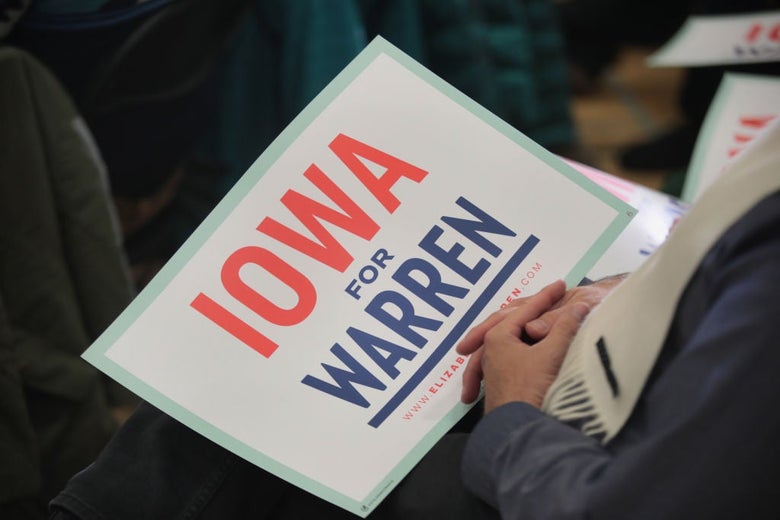
An Elizabeth Warren rally in Dubuque, Iowa, on Nov. 2.
Scott Olson/Getty Images
The New York Times released polls on Monday that show Democratic primary contender Elizabeth Warren trailing Donald Trump in head-to-head surveys of several swing states. Pundits are asserting that Warren’s support for eliminating private health insurance in a transition to full single-payer coverage will be general election suicide. Indiana Mayor Pete Buttigieg, who appeals to the same high-information college-educated voters whom Warren needs to do well with, is enjoying a mini-surge. The Democratic electorate continues to tell pollsters that “electability” is the most important attribute their nominee should have vis-à-vis Trump, and a writeup accompanying the Times’ new polls suggests that Warren, in part because she’s a woman, might not be considered “likable” enough to win. In sum, it is a PANIC cycle for Warren supporters—and to some extent, because she’s come to be considered the leading Democrat by some as Joe Biden underwhelms in debates and early state polls—for her party as whole.
As FiveThirtyEight’s Nate Silver points out, several other polls have put Warren ahead of Trump in swing states. Even pollsters of equally strong past reliability can make different guesses about who, demographically, is likely to show up on Election Day, and the Times’ poll makes a Democrat-unfriendly guess that there will be strong pro-Trump turnout in states with high white-working-class populations. If you are a liberal or leftist who wants to feel something other than despair, you can click here for other swing state polls, or here for a Tuesday Washington Post–ABC national poll that has Warren beating Trump by 15 points nationally (which, if recent national-to-state relationships hold, would be more than enough of a margin to carry swing states).
Or you can consider that Warren has been in a similar situation before. In January, a Times reporter appearing on CNN to discuss Warren’s just-announced “exploratory committee” activities asserted that, while Warren might know a lot about policy, her “likability” was in serious question. During the spring—in fact, at about the time of Buttigieg’s first media-driven surge—she trailed the more “electable” Biden nationally by more than 30 points. Political insiders wondered if she’d crippled herself by making a principled promise not to hold high-dollar fundraisers or give special access to major donors. Every conversation about her was legally required to include speculation that her past claims of American Indian ancestry would allow Trump to make her into a national punchline, or that working-class voters would perceive her as a scolding, shrewish nanny-state bitch monster because she was a law professor from Taxachusetts.
The thing about campaigns, though, is that they involve campaigning: persuading skeptical or unfamiliar voters to support you. And it would appear that Warren designed her campaign not just to make a positive case for herself, but to neutralize the concerns outlined in the previous paragraph. She got to Iowa—which, as the first state to be holding a vote, is the first available opportunity to prove “electability”—early and has seemingly been there since. She’s emphasized town hall appearances in rural areas, which is the opposite of relying on elite media buzz, and puts her “likability” to the test on a person-to-person basis. In another woman-of-the-people touch, she’s become known for taking selfies after every rally with anyone who wants to wait in line. She has made more than enough money from small donors to fund her campaign. Contra the idea that she has been lifted on the wings of radical millennial Twitter, she does well with older female voters who supported Hillary Clinton in 2016. Her standard stump speech goes heavy on her upbringing in Oklahoma and her struggles as a young mother, while her answer on the “Pocahontas” issue—that while family lore and DNA testing suggest she does have some Native ancestry, she doesn’t consider herself a person of color or member of a tribe—has been satisfactory enough that Democratic primary audiences, at least, no longer seem interested in it. She’s established a reputation, among those following the primary, as the candidate who has a geekish excitement for pursuing big projects, which, whatever its potential drawbacks, is better than being perceived as condescending and aloof.
All of this, to the extent it’s possible to measure, has worked. She has gone from being tied for fourth in Iowa to leading the field. She’s drawn to within single digits of Biden nationally and is the Democrat that the most potential primary voters, regardless of whom they support at the moment, say they’d be satisfied to have as the party’s nominee.
Warren’s reward for having persuaded Iowa voters and “high-information” Democrats nationally that she’s not too shrewish or extreme to be president is that she now gets to try to make that same case to a much larger audience. As the Times’ poll illustrates, the Electoral College divides this audience in such a way that Democrats are at a disadvantage even when the Republican candidate is nationally unpopular, and as the reaction to the Times’ poll illustrates, this disadvantage (and memories of 2016) have put many Democratic voters into a permanent state of second-order skittishness, afraid that the act of liking a candidate, through quantum MAGAtanglement, will cause a 58-year-old self-employed electrician named Dwayne Kowalcyzki in Bay City, Michigan, to hate that candidate. All the Democrats running for president, including Warren, should be aware of this. You might even say they will need to have a plan for it.
Support This Work
Help us cover the central question: “Who counts?” Your Slate Plus membership will fund our work on voting, immigration, gerrymandering, and more through 2020.
from Slate Magazine https://ift.tt/2oOaKIc
via IFTTT
沒有留言:
張貼留言